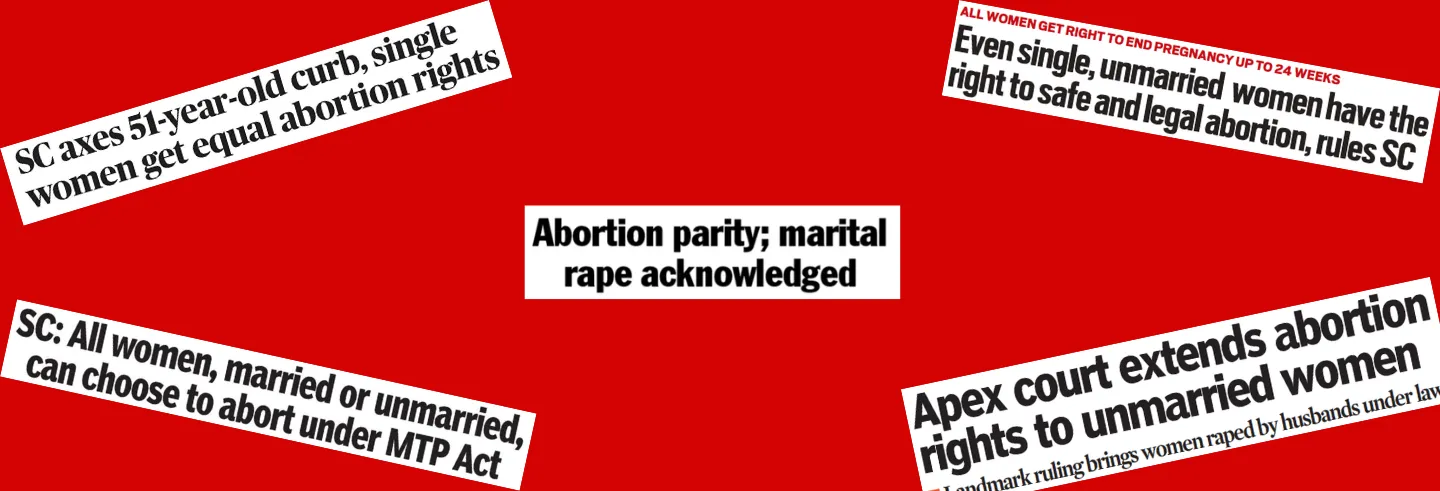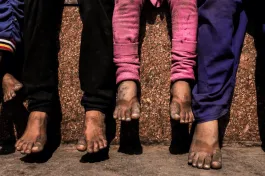In a recent address at the National Law University, Justice D.Y. Chandrachud, who is set to become the Chief Justice of India on 9 November 2022, urged young lawyers to pay heed to the feminine perspective as well when dealing with the law. He has led by example in many judgements, the most recent being in September 2022 when a bench headed by him allowed an unmarried woman to terminate a late-term pregnancy. This has been hailed as a landmark judgment for abortion rights in India because it has set a new standard for woman-centred abortion law, policies, and practice.
Before we get into the details of this judgment and what they mean, it is important to remind ourselves that recent amendments to India’s abortion law quite significantly enhance access to abortion. Earlier, only gynaecologists and doctors with an MBBS degree who underwent lengthy abortion-related training were authorised to provide both surgical and medical abortion. The Medical Termination of Pregnancy (MTP) (Amendment) Act 2021 changed that. It enabled the decentralisation of abortion services by permitting the creation of a cadre of doctors trained only in administering medical methods of abortion (non-surgical). The training is to be shorter and abortion services will eventually be available closer to women’s homes, even at primary health centres.
Prior to the amendments a woman who sought to terminate her pregnancy after 20 weeks of gestation had to obtain an authorisation from court. The amended law makes access easier by shifting the responsibility for authorisation to medical boards at the district level. It also includes single/unmarried women in its ambit under the broad category of those requiring an abortion due to failure of contraception. It recognises the vulnerability of certain categories of women who face excessive barriers to access—survivors of sexual assault, those who are physically challenged or mentally ill, those who carry a malformed foetus, and those undergoing a “change in status of relationship” (for instance, divorce or death of spouse)—and allows them up to 24 weeks to terminate an unwanted pregnancy.
[T]he judgement recognises that unmarried women and girls are also sexually active and should be accorded the same rights as married women.
It was the last mentioned provision that led a 25-year-old unmarried woman to approach the court for termination of her pregnancy. Her pregnancy had crossed the 20-week limit imposed by the MTP Act, but the status of her relationship had changed. Her plea was rejected by the Delhi High Court because single/unmarried women were not included among the special categories of women who could be allowed to have an abortion after an extended gestation. On approaching the Supreme Court, she obtained permission to terminate her pregnancy through a landmark judgement that is a significant step towards achieving reproductive justice in India. Let us briefly examine the key aspects of the judgement.
First, the judgement recognises that unmarried women and girls are also sexually active and should be accorded the same rights as married women. Despite India’s reluctance to accept that young men and women engage in sex before marriage, it does happen. For example, the “Youth in India: Situation and Needs” study conducted by the International Institute for Population Sciences (IIPS) and the Population Council in 2006-2007 found that 15% of young men and 3% of young women aged 15-24 across various states were sexually active. Evidence suggests that contraception among the young tends to be limited, and/or inconsistently practised. As a result, some sexually active adolescent girls and young women unwittingly become pregnant.
These young women fail to identify their pregnancy promptly, and when they do, experience multiple obstacles before they can access a facility where an abortion can be performed. Obstacles range from a lack of knowledge about abortion and difficulty in identifying an appropriate facility to accumulating the resources required and an absence of support at all levels—family, community, and even doctors. The time taken to overcome these obstacles further delays the abortion. By allowing unmarried women to avail themselves of the special status provision that allows abortion up to 24 weeks, the Supreme Court judgement has eliminated the need for them to seek court intervention for a delayed abortion. It has also laid the foundation for providing respectful and dignified abortion services to the unmarried, and asserted that abortion cannot be constitutionally denied to women irrespective of their marital status.
Taking cognisance of this situation and the problems it poses, the Supreme Court has in a giant step forward allowed minor females to abort their pregnancies from consensual sex without disclosing it to the police.
Second, the judgement recognises the need to protect the privacy of a minor. In 2012, India enacted the Protection of Children against Sexual Offences (POCSO) Act to strengthen the legal provisions for protecting children below the age of 18 years from sexual abuse, sexual harassment, and pornography. The Act requires a person who has knowledge that an offence under the Act has been committed or is likely to be committed to report it to the police. A failure to report is punishable and could lead to imprisonment for a maximum period of six months. This mandatory requirement is meant to protect children from any form of abuse, exploitation and neglect, but there is abundant anecdotal evidence from service providers to suggest that it hinders the access of minors to safe abortion services, especially in cases where the minor and/or her guardian do not wish to go to court.
What often happens in such cases is that pregnant women and girls either have their abortions done in unsafe/illegal places or carry the pregnancy to term without accessing ante-natal care. Taking cognisance of this situation and the problems it poses, the Supreme Court has in a giant step forward allowed minor females to abort their pregnancies from consensual sex without disclosing it to the police. The ruling clarifies that a doctor performing an abortion for a minor female (on request from the minor and/or guardian) is exempt from disclosing the identity of the minor to the police and in any criminal proceedings associated with the matter. This is expected to significantly improve the access of minors to abortion and the quality of care they receive.
Third, the judgement acknowledges that married women who have been forced into sex by their husbands have the same rights to seek a late abortion as women who have been raped. According to the 2019-21 National Family Health Survey, 6% (likely under-reported) of married women in India between the ages of 18 and 49 reported facing sexual violence by their husbands, and 29% experienced sexual or physical violence perpetrated by their husbands in the 12 months preceding their interview (IIPS and ICF 2021). Yet, India remains one of 36 countries where marital rape in not a criminal offence. Section 375 of the Indian Penal Code (IPC) says that “a man’s sexual relations with his wife, his wife who is no less than 15 years old, are not rape”.
Thus, a woman in an abusive marriage who desired to terminate an unintended pregnancy resulting from forced marital sex did not earlier have the right to do so. Aside from violating her rights, carrying an unintended pregnancy to term can pose a risk to a married woman’s physical and mental health. The Supreme Court judgement addresses this inequity. In a very significant move, the judgement states that the term rape or sexual assault will be presumed to include marital rape for the purpose of seeking an abortion under the law. With this, the court hopes to provide bodily autonomy to survivors of intimate partner violence.
The Court has ensured that women who become pregnant as a result of forced sex by their husband can avail themselves of the same rights as those raped by any man. And it has ensured that adolescents who seek an abortion are entitled to the same privacy and confidentiality as other abortion seekers.
The MTP Act was by itself an exception to the Indian Penal Code (IPC). The IPC still considers abortion/wilful miscarriage as an offence. The MTP Act overrides the IPC in cases where the abortion is performed in accordance with the conditions prescribed in it and its Rules. This judgement will be a precedence for similar future cases in courts allowing for an exception in the case of marital rape. In sum, the Supreme Court judgement has put women’s rights and autonomy at the centre of it all. It has provided disadvantaged women and girls what has been denied to them for ages—respectful, non-judgemental, and unbiased access to comprehensive abortion care. It has ensured that unmarried women have the same right as married women to terminate an unintended pregnancy. It has ensured that women who become pregnant as a result of forced sex by their husband can avail themselves of the same rights as those raped by any man. And it has ensured that adolescents who seek an abortion are entitled to the same privacy and confidentiality as other abortion seekers. What the bench has done in this landmark ruling is look at the current abortion law in the country through the lens of women’s rights and autonomy and identify areas that need change to make our law really women centred.
The Supreme Court judgement has laid down the rights of women. There is, however, a long way to go if we want to actually translate the provisions of the judgement into dignified access to abortion for women who need it. Policymakers, influencers, and service providers must be sensitised to the implications of this judgement, and current policies, programmes, and services must be reviewed to ensure that the rights this judgement confers on pregnant women are respected. To translate the provisions into action, directives must be developed that put the judgement’s provisions into practice in an enabling and woman-centric manner. Service providers have to be sensitised about the judgement and their responsibilities under these provisions, while women and girls have to be made aware of their right to seek an abortion under the new conditions.
Anisha Aggarwal and Vinoj Manning are with Ipas Development Foundation, New Delhi; Shireen J. Jejeebhoy is with the Aksha Centre for Equity and Wellbeing, Mumbai.










